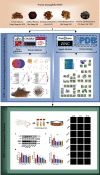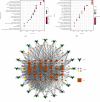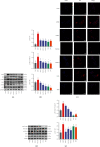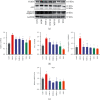Mechanism Investigation of Wuwei Shexiang Pills on Gouty Arthritis via Network Pharmacology, Molecule Docking, and Pharmacological Verification
- PMID: 36248423
- PMCID: PMC9568303
- DOI: 10.1155/2022/2377692
Mechanism Investigation of Wuwei Shexiang Pills on Gouty Arthritis via Network Pharmacology, Molecule Docking, and Pharmacological Verification
Abstract
Background: Gout is a common crystal-related arthritis caused by the deposition of monosodium urates (MSU). Tibetan medicine Wuwei Shexiang Pills (WSP) has been demonstrated to exhibit anti-inflammatory, antihyperuricemia, and antigout activities. However, the underlying mechanism is unknown.
Objectives: To explore the mechanisms of Wuwei Shexiang Pills on gouty arthritis via network pharmacology, molecule docking, and pharmacological verification.
Methods: The ingredients and targets of WSP were obtained by searching and screening in BATMAN-TCM and SwissADME. The targets involving the gout were acquired from public databases. The shared targets were put onto STRING to construct a PPI network. Furthermore, Metascape was applied for the GO and KEGG enrichment analysis to predict the biological processes and signaling pathways. And molecular docking was performed to validate the binding association between the key ingredients and the relative proteins of TNF signaling. Based on the serum pharmacology, the predicted antigout mechanism of WSP was validated in MSU-induced THP-1 macrophages. The levels of inflammatory cytokines and mRNA were measured by ELISA and qRT-PCR, respectively, and MAPK, NF-κB, and NLRP3 signaling-associated proteins were determined by western blot and immunofluorescence staining.
Results: 48 bioactive ingredients and 165 common targets were found in WSP. The data showed that 5-Cis-Cyclopentadecen-1-One, 5-Cis-Cyclotetradecen-1-One, (-)-isoshyobunone, etc. were potential active ingredients. TNF signaling, HIF-1 signaling, and Jak-STAT signaling were predicted to be the potential pathways against gout. The molecule docking analysis found that most ingredients had a high affinity for p65, NLRP3, IL-1β, TNF-α, and p38. The data from in vitro experiment showed that WSP suppressed the production and gene expression of inflammatory cytokines. Furthermore, WSP could inhibit the activation of MAPK, NF-κB, and NLRP3 signaling pathways.
Conclusion: Our finding suggested that the antigout effect of WSP could be achieved by inhibiting MAPK, NF-κB, and NLRP3 signaling pathways. WSP might be a candidate drug for gouty treatment.
Copyright © 2022 Jirui Lang et al.
Conflict of interest statement
The authors declare that there are no conflicts of interest regarding the publication of this paper.
Figures








Similar articles
-
LC-MS-based metabolomics reveals the mechanism of anti-gouty arthritis effect of Wuwei Shexiang pill.Front Pharmacol. 2023 Aug 11;14:1213602. doi: 10.3389/fphar.2023.1213602. eCollection 2023. Front Pharmacol. 2023. PMID: 37637422 Free PMC article.
-
Potential anti-gout properties of Wuwei Shexiang pills based on network pharmacology and pharmacological verification.J Ethnopharmacol. 2023 Apr 6;305:116147. doi: 10.1016/j.jep.2023.116147. Epub 2023 Jan 3. J Ethnopharmacol. 2023. PMID: 36608779
-
Component identification of modified sanmiao pills by UPLC-Xevo G2-XS QTOF and its anti-gouty arthritis mechanism based on network pharmacology and experimental verification.J Ethnopharmacol. 2023 Jul 15;311:116394. doi: 10.1016/j.jep.2023.116394. Epub 2023 Mar 20. J Ethnopharmacol. 2023. PMID: 36940736
-
Palmatine Protects Against MSU-Induced Gouty Arthritis via Regulating the NF-κB/NLRP3 and Nrf2 Pathways.Drug Des Devel Ther. 2022 Jul 2;16:2119-2132. doi: 10.2147/DDDT.S356307. eCollection 2022. Drug Des Devel Ther. 2022. PMID: 35812134 Free PMC article.
-
Exploration of the mechanism of Zisheng Shenqi decoction against gout arthritis using network pharmacology.Comput Biol Chem. 2021 Feb;90:107358. doi: 10.1016/j.compbiolchem.2020.107358. Epub 2020 Aug 8. Comput Biol Chem. 2021. PMID: 33243703 Review.
Cited by
-
LC-MS-based metabolomics reveals the mechanism of anti-gouty arthritis effect of Wuwei Shexiang pill.Front Pharmacol. 2023 Aug 11;14:1213602. doi: 10.3389/fphar.2023.1213602. eCollection 2023. Front Pharmacol. 2023. PMID: 37637422 Free PMC article.
-
Evaluation indicators of Traditional Chinese Medicine syndromes for gouty arthritis with damp heat accumulation and the effect of administering Tongfeng Qingxiao formula.J Tradit Chin Med. 2024 Dec;44(6):1204-1216. doi: 10.19852/j.cnki.jtcm.20240706.001. J Tradit Chin Med. 2024. PMID: 39617706 Free PMC article.
-
Based on the TLR4/NLRP3 Pathway and Its Impact on the Formation of NETs to Explore the Mechanism of Ginsenoside Rg1 on Acute Gouty Arthritis.Int J Mol Sci. 2025 Apr 29;26(9):4233. doi: 10.3390/ijms26094233. Int J Mol Sci. 2025. PMID: 40362468 Free PMC article.
-
Integrated Data Mining and Animal Experiments to Investigate the Efficacy and Potential Pharmacological Mechanism of a Traditional Tibetan Functional Food Terminalia chebula Retz. in Hyperuricemia.J Inflamm Res. 2024 Dec 17;17:11111-11128. doi: 10.2147/JIR.S484987. eCollection 2024. J Inflamm Res. 2024. PMID: 39713714 Free PMC article.
-
Gouty arthritis patients' diagnostic, biochemical, and hematological characteristics study: a single-center retrospective study.BMC Musculoskelet Disord. 2024 Dec 20;25(1):1054. doi: 10.1186/s12891-024-08151-0. BMC Musculoskelet Disord. 2024. PMID: 39707267 Free PMC article.
References
LinkOut - more resources
Full Text Sources

